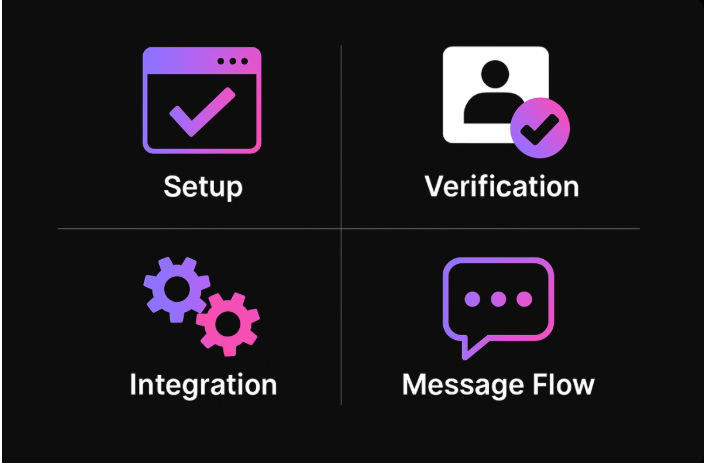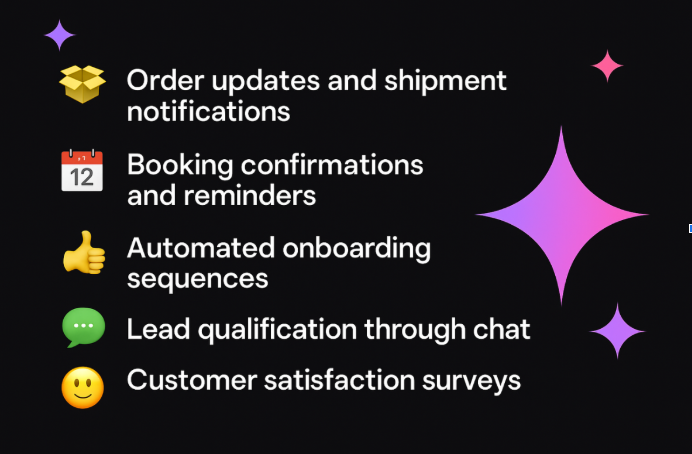
If you’re trying to connect with today’s consumers, you can’t rely on outdated tools or channels they’ve stopped using. Customers expect quick, personalized communication, and they expect it on the platforms they already live on. That’s where WhatsApp API steps in.
In this article, we’ll look at how WhatsApp API works, what makes it a game-changer for business messaging, and how to use it effectively in your organization.
What Is WhatsApp API Integration?
Let’s start with the basics.
At its core, WhatsApp API integration for business allows brands to communicate with users over WhatsApp in a structured, scalable way.
Unlike the basic WhatsApp Business app, which is designed for small businesses with limited messaging needs, the API is built for medium to large businesses that need automation, CRM integration, and bulk messaging, all while complying with WhatsApp’s strict rules on user consent.
This isn’t just another messaging app. It’s a powerful communication infrastructure, often referred to as a messaging API, that connects your backend systems (like CRM or customer service platforms) directly to WhatsApp.
How WhatsApp API Works
This part tends to confuse people at first, but it’s simpler than it sounds.
Unlike traditional apps that you can download and start using right away, the WhatsApp Business API is not a standalone platform. It functions as a backend interface that developers connect to via HTTP requests.
It doesn’t come with a front-end or interface of its own. You’ll need to integrate it with existing software or use it through a third-party provider.

Here’s the deal:
- Setup: Businesses apply for access to the API through a provider (called a Business Solution Provider or BSP) or through Meta directly.
- Verification: Meta verifies the business, phone number, and intent of use.
- Integration: The API is integrated into customer systems like CRMs, helpdesk tools, or marketing automation platforms.
- Message Flow: Businesses can then send messages (within WhatsApp’s guidelines) to opted-in users through automated or manual workflows.
In practical terms, it enables chatbots, customer service agents, and transactional messaging, all from a single WhatsApp-enabled backend.
Why Your Business Needs WhatsApp API Integration
So, why does this matter? Because expectations around customer communication have changed.
People don’t want to wait on hold or dig through emails. They want fast answers, relevant updates, and human support, all on their terms.
Here’s why WhatsApp API integration for business is more than just a nice-to-have.
1. Real-Time, Global Reach
WhatsApp has more than 2 billion users worldwide. By integrating your systems with WhatsApp, you're meeting customers where they already are.
With WhatsApp API integration for business, messages are delivered instantly, making it perfect for time-sensitive updates or high-touch support.
2. Automation That Feels Human
That said, speed alone isn’t enough. The API allows for rule-based automation or AI-powered chatbots that handle routine inquiries, without making conversations feel robotic. From order tracking to FAQs, bots can take over, while complex issues escalate to human agents.
3. Secure, Compliant Messaging
Privacy isn’t just a checkbox anymore - it’s a customer expectation. WhatsApp offers end-to-end encryption, which is crucial for industries like healthcare, banking, and e-commerce.
Plus, businesses can only message users who’ve opted in, creating a naturally filtered and high-intent audience.
4. Scalable Conversations
As your business grows, so do your conversations. Unlike the WhatsApp Business App (which is limited to a single device and a small user base), the API supports thousands of conversations at once, perfect for support centers and marketing teams working across time zones.
How to Integrate with WhatsApp API
Ready to connect the dots between your business systems and WhatsApp? Here's how to do it the right way.

Step 1: Register and Verify Your Business with Meta
Start by creating or accessing your Meta Business Manager account. From there, you’ll need to:
- Register your business on Meta Business Manager.
- Verify your business identity
- Add a phone number (it must be a number that isn’t already linked to another WhatsApp account)
This is the first step in getting approved for WhatsApp API integration for business.
Step 2: Choose a Business Solution Provider (BSP)
Unless you plan to self-host (which is rare), selecting a BSP is the most straightforward path. These providers streamline the entire process and often offer helpful dashboards or no-code interfaces that reduce development work.
Step 3: Submit Message Templates
Before sending outbound messages, you must create and submit pre-approved templates. This ensures compliance with WhatsApp’s rules and prevents misuse of the platform.
Step 4: Connect the API to Your Tech Stack
Once verified, you’re ready to integrate with WhatsApp API by connecting it to your CRM, customer support tools, or marketing automation platform. This is the core of WhatsApp API integration for business—bringing WhatsApp into your daily operations.
Many BSPs offer plug-and-play solutions, while more technical teams can connect via HTTP requests using webhook-based events and API endpoints.
Step 5: Start Messaging Through the API
Once live, your business can:
- Respond to inbound inquiries (session messages within 24 hours)
- Send proactive, template-based outbound messages
- Automate messaging workflows (e.g., follow-ups or delivery updates)
- Enable chatbots or live agents inside WhatsApp
That’s how it works, no frontend, just powerful backend infrastructure that gives your business scalable, secure, and real-time communication capabilities.
And, for advanced users, use webhook-based events and message status tracking to dynamically trigger workflows, such as sending a follow-up if delivery is delayed or if a customer hasn’t replied in 48 hours.
What Can You Do with WhatsApp API?
With WhatsApp API, you can do a lot more than with most other tools:
- Order updates and shipment notifications
- Booking confirmations and reminders
- Automated onboarding sequences
- Lead qualification through chat
- Customer satisfaction surveys

And if you’re running a marketing campaign, the API makes it easier to deliver timely, relevant offers without spamming users or breaking compliance rules.
Wrap-Up: Making WhatsApp API Work for You
If customer communication is a priority, which it should be, then the WhatsApp Business API is one of the best tools available today. It’s fast, scalable, secure, and built for businesses that want to move quickly without losing their personal touch.
But the real magic happens when you use it strategically. Knowing how to integrate WhatsApp Business API is only the first step. The next step is choosing the right tools and partners to bring your messaging vision to life.
This is where TopMessage can help. With deep expertise in API onboarding, personalized support, and a platform designed to grow with you, TopMessage makes it easy to reap the full potential of WhatsApp for your business.
FAQs
Does WhatsApp Have an API?
Yes, it does. But it’s not available to just anyone. The WhatsApp API is designed for medium to large businesses with significant messaging volume. It’s not something you download—it must be integrated.
Is WhatsApp API Only Meant for Customer Support Purposes?
Not at all. While customer service is a major use case, the API supports broader goals like sales outreach, feedback collection, and internal notifications.
Can I use WhatsApp API without a developer?
In most cases, no. However, many BSPs provide no-code or low-code solutions, making it accessible to non-technical teams.
How is WhatsApp API priced?
Costs typically include a per-message fee (set by Meta and tiered by country), plus a BSP’s hosting or service charges. Message type (session vs. template) also impacts pricing.
How long does it take to get approved?
Approval timelines vary but typically range from 1 to 10 business days, depending on verification and message template approvals.
Can multiple agents use WhatsApp API simultaneously?
Yes. Unlike the WhatsApp Business App, the API supports multiple users through third-party tools or custom-built dashboards.
Is there a difference between the WhatsApp Business App and API?
Yes. The app is for small teams with basic needs; the API is designed for scaling communications and integrating with business systems.